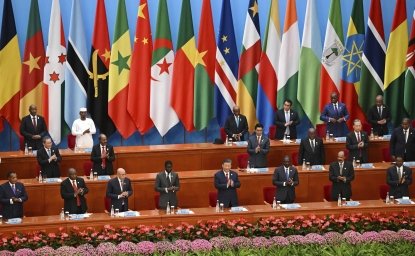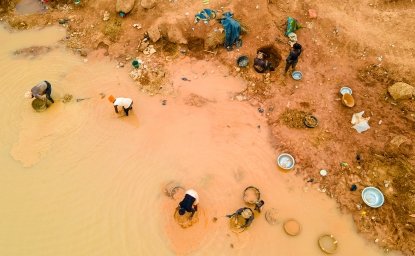In the summer of 2020, border tensions between India and China and the future of their bilateral relations came to dominate the news cycle in the subcontinent—or at least the space left over by the coronavirus pandemic. Although foreign policy experts are right to discuss the boundary dispute at the core of India-China tensions, they must not ignore the many other potential sources of tensions. One of the most significant is the probable implementation of large-scale geoengineering projects.
As emissions reductions prove elusive, major emitters are increasingly looking for other solutions to reduce global warming. Both China and India are exploring carbon dioxide removal or negative emission technologies. More controversially, they are also studying solar radiation management, a technological domain in which China is far ahead of India and the risk of bilateral disagreement is extremely high. The foreign policy community needs to incorporate climate change issues—especially geoengineering—into foreign policy.
Geoengineering’s Potential to Heighten Tension
The emergence of ambitious geoengineering technologies could exacerbate tensions and even hostility between nations such as India and China. Without regulation, one country’s efforts could affect other countries. While China has not yet shown signs of “unilaterally” deploying geoengineering projects on the ground, the scale of its weather modification and other massive engineering projects, including mega-dam projects (such as the Three Gorges), suggests China is willing to deploy large-scale geoengineering schemes to tackle the impacts of climate change and achieve its Paris targets.
Take, for example, China’s large-scale weather modification project, Tianhe, or Sky River—a cloud seeding geoengineering project. The project has potential security implications for neighboring countries, including India, and other South and Southeast Asian countries.
Tianhe’s climate geoengineering venture aims to manage drought-like conditions in the northern parts of the county that receive less rainfall and are seeing declining water levels in its rivers. With the project, China seeks to blast silver iodide particles into the atmosphere using fuel-burning chambers in order to transfer more water from the Yangtze River basin to the Yellow River basin via water vapor that becomes rainfall.
If past patterns repeat, conflicts may arise. India has accused China of creating floods in its northeast through suspicious dam-building activities. The Tianhe project could further heighten concerns in the South and Southeast Asian regions, as the Tibetan Plateau is the source of major rivers such as the Indus, and Brahmaputra. Some Chinese scientists regard the project, led by researchers from Tsinghua University and Qinghai University, as technically “unfeasible,” and scientifically “delusional.” But if it is to go through, it could unpredictably affect local and transboundary ecosystems, precipitation patterns, and even the long-term regional climate. These variables could raise the importance of information and data sharing (transparency) that is at times held hostage by geopolitical dynamics, as was the case during the 2017 Doklam military standoff between India and China, when owing to “technical” reasons, the latter did not share water flow data with the former.
Just how solar geoengineering may affect regional climate and weather patterns is unclear, but the impacts are potentially significant. Climate change already seems to be affecting the Indian Summer Monsoon Rainfall (ISMR) that is the lifeline of all the South Asian economies. Studies have attributed a decline in the total rainfall and a concurrent rise in the magnitude and frequency of extreme rainfall events to climate change in many parts of India and other South Asian countries. A few scientific studies have also pointed out that using techniques such as injection of stratospheric aerosols to cool the planet (the effect is comparable to that of a volcanic eruption) may reduce rainfall in India and China and may affect the ozone layer too, by thinning it. The deployment of such initiatives in the region could therefore unleash far-reaching repercussions for ecological, livelihood, economic, social, and human security.
The Geopolitical Divide Between the Haves and Have-Nots
The consequences of a lack of safeguards on unregulated geoengineering could be disastrous, particularly for developing countries that do not possess enough resources to undertake research and development (R&D) in the field, deploy such schemes on a large-scale, or deal with their unintended outcomes. Geoengineering research, especially solar geoengineering, both in terms of technological innovation and futuristic governance frameworks, continues to be dominated by the Global North (primarily North America and Western Europe).
These dynamics could exacerbate the geopolitical divide between the haves and have-nots or winners and losers, an asymmetry in the international system that developing countries have long contested. Yet, scientists have spoken about the need to implement geoengineering not just to prevent a future climate emergency, but also to create “equity” in connection with the possibility of reducing surface temperature faster than mitigation, in a way that will be comparatively cheaper than adaptation, and as a moral obligation to save the global poor.

The Military Factor
Wherever militaries are involved, we should proceed with caution. In some countries, the military may already be playing a role in developing these technologies. If and when the technologies are deployed on a wide scale, militaries may be involved in various aspects of the process, including the protection of project sites, R&D, and potential militarization/weaponization (to have an upper hand in times of crises).
Tianhe, in fact, is being aided by the state-owned China Aerospace Science and Technology Corporation, a “major space and defense contractor,” using “cutting-edge military rocket engine technology” and “satellite network.” The involvement of the militaries in an already geopolitically tense region without appropriate safeguards could lead to further opaqueness, mistrust, disagreements, and conflict over the use of such technologies.
Some argue that geoengineering governance research should be free of regulations that may politicize the debate, delay effective means of arresting the effects of climate change, and even lead to a potential moratorium on the use of these technologies. Others argue that there is not enough scientific evidence to prove the risks associated with geoengineering. This is precisely why we cannot wait for perfect information to act, and we may have to adopt a cautious approach that looks to diplomatic efforts to deal with the effects of these technologies, if not impose a ban on them.
Designing Geoengineering Governance Frameworks
Concerned foreign policy and security stakeholders in the Global South will need to step up efforts to address the political, security, and governance-related implications of geoengineering schemes. The focus of geoengineering should shift from mere preoccupation with the global context to regional climate change, as the impacts of these technologies on a regional scale (including precipitation and hydrologic cycle) are still under-studied. In a region such as South Asia, countries should cooperate. First, they should reach a common understanding on the role of climate geoengineering as a “plan B” solution for tackling climate change, and help advance the discussion on and implementation of national regulatory frameworks (which are non-existent in most cases). Then they should design rules and norms that draw upon these frameworks and that can be used at the international level for developing a global governance, or regulatory, framework.
Accountability and transparency are the key to future global, regional, and national climate governance. Although most countries, including China, the United States, and India have ratified the Convention on the Prohibition of Military or Any Other Hostile Use of Environmental Modification Techniques (ENMOD), establishing “compliance” and liability can be tricky in the event of perceived (or claimed) benign use of climate geoengineering, coupled with the existence of longstanding militarized border zones. According to ENMOD, states must “undertake not to engage in military or any other hostile use of environmental modification techniques having widespread, long-lasting or severe effects as the means of destruction, damage or injury to another State party.” This is perhaps the most relevant legal framework that could cater to the security implications of climate geoengineering, albeit only in “hostile” scenarios. It is outdated and does not address “peaceful” modification techniques.
In the present situation the uncertainties have multiplied, with the COVID-19 pandemic, geopolitical tensions, and climate change complicating existing challenges. With the pandemic, although there are never-ending calls for a “green recovery”—"to build back better”— some speculate that many renewable energy projects are likely to be delayed. In such a scenario, countries will be more ambitious about pushing ahead with geoengineering projects to achieve their climate objectives. Richer countries may set aside ethical concerns with regard to developing countries and pursue a technocratic solution to climate change. In this context, the need for better governance mechanisms and tools, and the role of foreign policy stakeholders, especially those who engage in climate diplomacy, will be paramount, including in regions such as South Asia.
Sources
Adelphi & Germany’s Federal Foreign Office: Climate Diplomacy Project, Ambio, American Association for the Advancement of Science, American Geophysical Union Journal of Geophysical Research, BBC News, China Daily, China-Geoengineering.org, DownToEarth, Conflict and Environment Observatory, Energy Procedia, EPW Engage, International Environmental Agreements: Politics, Law and Economics, Nature Communications, Nevada Law Journal, Philosophical Transactions A, Phys.org, PR Newswire, ScienceAlert, South China Morning Post, S. Rajaratnam School of International Studies, The Economic Times, The Guardian, The National Academies, The Wire, United Nations Office at Geneva
Author

Environmental Change and Security Program
The Environmental Change and Security Program (ECSP) explores the connections between environmental change, health, and population dynamics and their links to conflict, human insecurity, and foreign policy. Read more


Global Risk and Resilience Program
The Global Risk and Resilience Program (GRRP) seeks to support the development of inclusive, resilient networks in local communities facing global change. By providing a platform for sharing lessons, mapping knowledge, and linking people and ideas, GRRP and its affiliated programs empower policymakers, practitioners, and community members to participate in the global dialogue on sustainability and resilience. Empowered communities are better able to develop flexible, diverse, and equitable networks of resilience that can improve their health, preserve their natural resources, and build peace between people in a changing world. Read more

Explore More
Browse Insights & Analysis
Lights On or Off? Chinese Solar and Wind Companies in Sub-Saharan Africa

COP29 Negotiations at Crossroads: Financing and Emission Pledges Remain Unresolved

There's Mining, Then There's Galamsey

